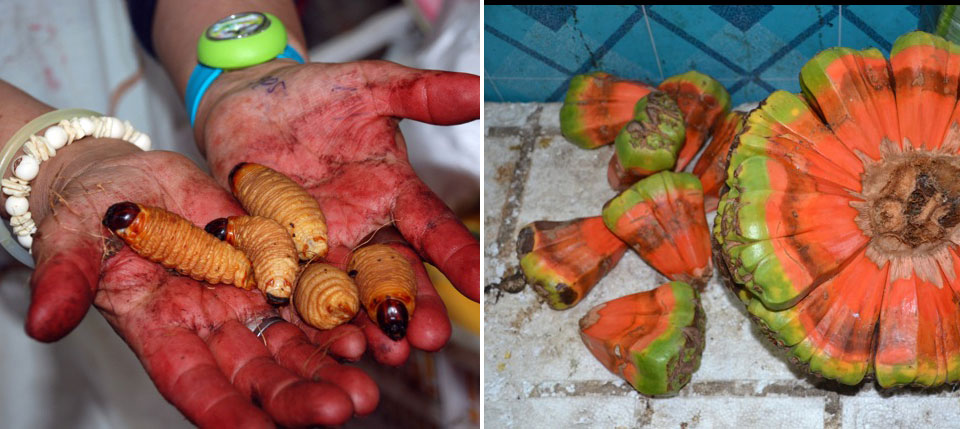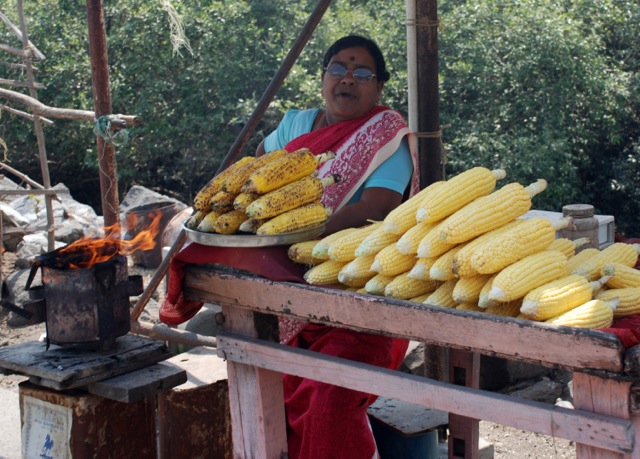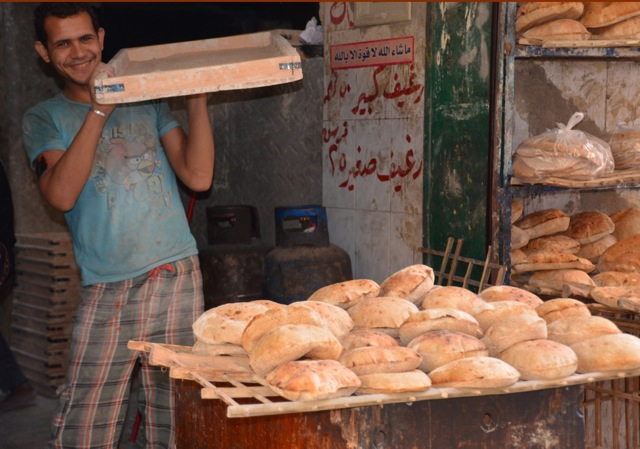Paulette Mitchell might have your dream job. As an enrichment speaker on cruise ships, she has traveled to over 120 countries and gives presentations on the cuisine of each port of call. Of course, the first thing this passionate cook does when the ship docks is head to the street markets; it’s where she finds inspiration for new recipes. We sat down with her to chat about what she’s learned from her market adventures, what it’s like coming face to face with a severed camel head and why she always takes time to chat with vendors about their produce. She also gave us a tasty chicken recipe from Zanzibar to share with you!
Paulette on what’s she’s learned about a place and its culture through its food…
“In my opinion, the local market is the best place to begin in any city. Locals come to the market not just to shop, but also to eat, drink, and to mingle with friends. We are visitors and voyeurs, but the real shoppers in the markets are choosing what to feed their families for dinner. I love to watch how people relate to one another. Sometimes they are jovial, and in other countries everyone seems quite solemn. Some populations are quiet and sophisticated, others more frenzied. Shoppers may bargain, yet in other locales that is not acceptable. When greeting one another, friends may hug and even kiss. Yet sometimes a polite distance is maintained between people. This not only is interesting to view but also offers an incite in how to behave as a traveler.
We are visitors and voyeurs, but the real shoppers in the markets are choosing what to feed their families for dinner.
I like to chat with vendors about favorite recipes using the ingredients at their market stands. I also like to ask them, “What do you do on your day off.” Their minds switch from talking to me as a tourist, and this is how I find some of the most interesting places to go, as well as the best local restaurants.”
In Stone Town, Zanzibar, Paulette discovered a simple yet tasty recipe for Zanzibar Chicken. Scroll down for the recipe!
Paulette’s favorite food markets around the world…
“All food markets fascinate me because they not only offer a feast for the senses but also provide insight into the culture.
For example, I love the sophisticated neighborhood markets in Paris, where shoppers arrive without a list and let their five senses take over. In China, freshness in imperative and this is evident in their markets. Live chickens squawk, and fish swim in bins. Even herbs and many vegetables are sold with roots attached so they also are still “alive.” The Chinese believe that food is consumed not only for good flavor but also to promote health, and I think that Americans can learn a great deal from this philosophy.
All is not, however, beautiful and pleasantly aromatic and exploring a local market can force you out of your comfort zone. For example, I’ve witnessed stands of camel heads at the central market in Mombasa, and at sidewalk markets in Luganville, Vanuatu, I was surprised to see piles of fruit bats, which are considered a delicacy in many Asian and Pacific Rim cultures.In Cambodia and parts of Asia, you can smell the pungent odor of durian from afar. So not all is beautiful and pleasantly aromatic. Yet, I love the way that markets show the reality of life around the world.”

Camel Heads in Mombasa’s Central Market, Rambutans in Stone Town, Zanzibar. Images courtesy Paulette Mitchell
So not all is beautiful and pleasantly aromatic.Yet, I love the way that markets show the reality of life around the world.
Paulette on unusual foods she’s encountered…
“When visiting food markets around the world, I seek the distinctive, local ingredients, especially those that are unfamiliar. Rambutan is Malay for “hairy,” and this is the name of a red, spiky fruit native to tropical Southeast Asia. It has now spread to other parts of the world, including Africa. At the Darajani Central Market in the Stone Town area of Zanzibar, the fruit is displayed in colorful clusters in giant bins on the streets. The fruit beneath the hairy exterior is white or pale pink with a sweet, mildly acidic flavor reminiscent of grapes.
I first saw screw pine at a market in Male, Maldives. It’s colorful and photogenic. This fruit, sometimes called pandanus, comes from a tropical plant that grows in rain forests. It changes from green to bright orange or red as it matures. The fleshy pulp of the fruit may be eaten raw or cooked. Sometimes it is pressed to make juice.
A popular Peruvian food is “suri worms,” a type of Amazonian grub. They are found in the trunks of aguaje palms, which grow in wet areas of South America. Brochettes of this delicacy are skewered and grilled to make a treat described as “soft, mushy, and delicious.” While in Lima, I photographed vendors selling the worms, but I didn’t have an opportunity to sample this specialty. Maybe next time!”
Paulette’s favorite street food from around the world…
“Street vendors in Mumbai grill corn on the cob over charcoal fires until the sweet kernels are tender and blackened. The corn is then rubbed with fresh lime juice and a potent mixture of spices. The irresistible combination is sweet, tangy, smoky, salty, and spicy.”
“In Cairo, I just can’t get enough of the traditionally-baked Egyptian pita bread, which rolls out of street-side ovens warm, lightly browned, puffy, and airy on the inside. This bread is the cornerstone of Egyptian cuisine. It’s not only a major component of the meal, but bread is also used as an eating utensil. For me, it’s a welcome snack.”
One of the advantages of taking time to explore food markets and chat with local shoppers and vendors, is discovering new recipes. Paulette shares one of her favorites, a tasty simple chicken dish from Zanzibar.
ZANZIBAR CHICKEN
Zanzibar is known as the “Spice Island,” and cloves, nutmeg, cinnamon, and pepper are essential ingredients in their cuisine. If you have the opportunity to visit Zanzibar, be sure to include a spice plantation tour. It’s interesting to see how spices grow and also to learn about their health-promoting properties. For example, in Zanzibar cinnamon is used as a remedy for headaches.
Makes 4 servings
Chicken thighs are traditional, but this aromatic dish can also be made with boneless, skinless chicken breasts. Serve with rice.
Ingredients
2 teaspoons ground cinnamon
1/2 teaspoon salt
1/4 teaspoon freshly ground pepper
1 1/2 pounds chicken thighs (2 thighs per serving)
2 tablespoons canola oil
1 medium onion, coarsely chopped
2 cloves garlic, finely chopped
3/4 cup fresh orange juice
1/4 cup raisins
1/3 cup slivered or sliced almonds
Preparation
Step 1: Combine the cinnamon, salt, and pepper in a small bowl. Season both sides of the chicken with the spice mixture.
Step 2: Heat the oil in a large skillet over medium-high heat. Add the chicken. Cook, turning occasionally, for about 10 minutes or until lightly browned but not thoroughly cooked. Use tongs to transfer the chicken to a bowl.
Step 3: Add the onion to the pan. Cook for about 3 minutes or until softened. Add the garlic and stir for about 1 minute.
Step 4: Return the chicken to the pan. Add the orange juice and raisins. When the liquid begins to bubble, reduce the heat to medium. Cover and simmer for 15 minutes or until the chicken is tender.
Serve: Drizzle some of the sweet sauce over the chicken and garnish with almonds.
You can purchase Paulette’s cook books over here!
At Project Bly, we believe that a city is a living, breathing organism, and to get to know it you have to wander its streets, the veins that fork and converge and inevitably lead you to its heart—the marketplace.











